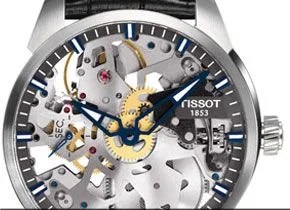5 photos
If you remember anything from high school biology class outside of horrifying dissections, you’re well aware that “skeleton” refers to the essential hard inner structure of an organism. Well, it’s the same with watches. In a skeleton timepiece, all of the non-essential material in the movement is cut away (often called “open worked”) and the dial is eliminated to reveal the inner organs, so to speak. What’s left is the “skeleton”, which holds those organs together and gives them structure. Skeleton watches, or squelettes in French, have been made since the pocketwatch days and typically are ornate, baroque displays of artistry. The Tissot T-Complication Squelette ($1,950) offers a far more modern and industrial take on this classic genre. We got our hands on one for a week, and it really got under our skin.
MORE TIME ON OUR HANDS Montblanc Timewalker Hemispheres | Chronograph Shootout |
The real joy in owning a skeleton watch is in observing the second-to-second action that’s hidden from view in a normal watch. It’s an eyes-on lesson on how a watch works. How does the mainspring get wound? Why doesn’t it unwind again as soon as you release the crown? How does the power get transferred through all those gears? Where does the signature tick-tick-tick of a mechanical timepiece come from? Spend some time with a nice big skeleton timepiece based around a movement like the Squelette’s Unitas 6497, where everything seems big enough to get at with a knife, fork, and spoon, and you’ll see plenty of examples within the miniature horological laboratory on your wrist.
The Squelette is particularly special in this regard. All the wheels, pinions, springs and balance have come out to play; the mainspring barrel even has cut-outs, so you’ve got a visual confirmation of whether or not the watch has some power left in reserve, assuming you know what you’re looking for.
Tick List






